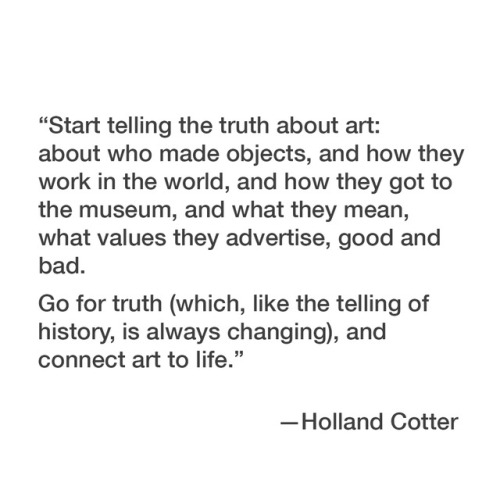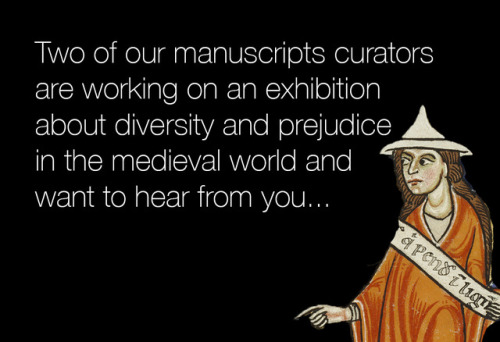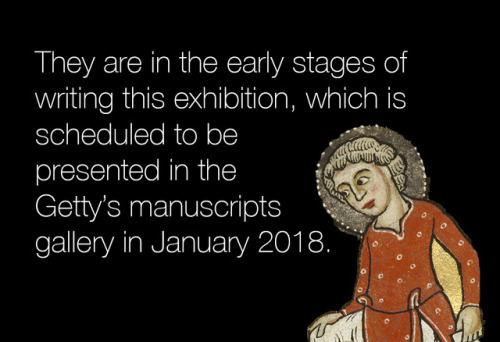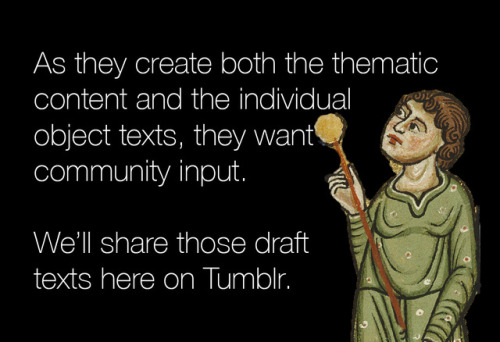thegetty: thegetty:Dialogue: Exposing the Rhetoric of Exclusion through Medieval Manuscripts By Kr
thegetty: thegetty: Dialogue: Exposing the Rhetoric of Exclusion through Medieval Manuscripts By Kristen Collins and Bryan Keene, originally published on the Getty Iris We invite your thoughts on an exhibition-in-progress at the Getty that addresses the persistence of prejudice as seen through lingering stereotypes from the Middle Ages. As curators in the Getty Museum’s department of medieval and Renaissance manuscripts, we are interested in how books, and museum collections more broadly, can spark dialogues about inclusivity and diversity. Our manuscripts collection at the Getty consists primarily of objects from Western Europe, which can present challenges when trying to connect with a multicultural and increasingly international audience. We are striving to make connections between the Middle Ages and the contemporary world—connections that may not be immediately evident, but are powerful nonetheless. Museums are inherently political organizations, in terms of the ways that collections are assembled, displayed, and interpreted. This year’s meeting of the Association of Art Museum Curators addressed how institutional narratives and implicit bias can skew ideas of history and culture in ways that exclude minorities and gloss over the shameful aspects of our past. Groups such as the Medievalists of Color, the Society for the Study of Disability in the Middle Ages, the Society for Medieval Feminist Scholarship, and the Society for the Study of Homosexuality in the Middle Ages, among others, are applying similar lines of inquiry, seeking to decolonize and diversify the field of medieval studies. We stand with these groups. We were also inspired by Holland Cotter’s call to arms, as he exhorted museums to tell the truth about art, “about who made objects, and how they work in the world, and how they got to the museum, and what they mean, what values they advertise, good and bad. Go for truth (which, like the telling of history, is always changing), and connect art to life.” Here is our description of the exhibition, still in draft form: Medieval manuscripts preserve stories of romance, faith, and knowledge, but their luxurious illuminations can reveal more sinister narratives as well. Typically created for the privileged classes, such books nevertheless provide glimpses of the marginalized and powerless and reflect their tenuous places in society. Attitudes toward Jews and Muslims, the poor, those perceived as sexual or gender deviants, and the foreign peoples beyond European borders can be discerned through caricature and polemical imagery, as well as through marks of erasure and censorship. As repositories of history and memory, museums reveal much about our shared past, but all too often the stories told from luxury art objects focus on the elite. Through case studies of objects in the Getty’s collection, this exhibition examines the “out groups” living within western Europe. Medieval society was far more diverse than is commonly understood, but diversity did not necessarily engender tolerance. Life contained significant obstacles for those who were not fully abled, wealthy, Caucasian, Christian, heterosexual, cisgender males. For today’s viewer, the vivid images and pervasive narratives in illuminated manuscripts can serve as a stark reminder of the power of rhetoric and the danger of prejudice. We begin the exhibition with a masterpiece of Romanesque painting, shown above. This manuscript, with its gilded pages and geometric symmetry, reveals the institutionalized antisemitism that formed the basis of Christian rhetoric about the triumph of the Church. Ecclesia, the personification of the Christian Church, is seen above and to Christ’s right, while the Jewish Synagoga appears on Christ’s left. Often represented as a blindfolded figure, here Synagoga (in red robes) points at Christ, glaring. She holds a banderole representing Old Testament law that proclaims “cursed be he who hangs on the tree.” Below, two additional personifications echo and intensify the antithetical positions of these two figures. In a roundel below Ecclesia, the fair-skinned figure of Life (at far left) gazes calmly across the composition at Death, whose dark complexion and hook nose are seen in caricatures of Jews in other twelfth-century images. We’d Like Your Comments We are in the early stages of writing this exhibition, which is scheduled to be presented in the Getty’s manuscripts gallery in January 2018. As we create both the thematic content and the individual object texts—which we will be posting periodically on the Getty Tumblr—we are curious to receive community input. Specifically, we are curious to know any or all of the following: Your level of interest in an exhibition of medieval and Renaissance art exploring these themes Comments on the wording of the exhibition description we’ve shared above (as a whole or in any part) Suggestions for perspectives and points of view we should consider in developing the exhibition Any and all other suggestions or criticisms Please reblog with your comments, DM us, or contact the curators directly by email at manuscripts@getty.edu. UPDATE: SEPTEMBER 2017 Thank you for sharing your words of wisdom, feedback, and reactions. The curators of “Outcasts” would like to continue the conversation, be transparent, and want to share working drafts of their artwork descriptions and wall texts. We’ll do so here. Draft of the introductory text: The exhibition Outcasts: Prejudice and Persecution in the Medieval World will examine the “out-groups ” living within western Europe through case studies of works drawn from the Getty’s collection. Medieval society was far more diverse than is commonly understood, but diversity did not necessarily foster tolerance. Life presented significant obstacles for those who were not fully-abled, white, wealthy, Christian, heterosexual, cisgender males. For today’s viewer, the vivid images and pervasive narratives in illuminated manuscripts can serve as a stark reminder of the power of rhetoric and the danger of prejudice. We’ll reblog and add individual draft wall label texts and the associated images. These texts were written with a few constraints in mind: Write engaging text in 120 words Explore the historical and artistic content Describe the contents or function of the manuscript -- source link
Tumblr Blog : thegetty.tumblr.com
#medieval#middle ages#history#museums




